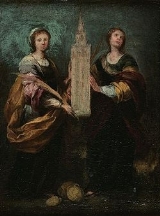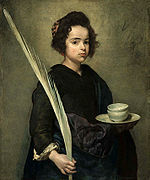
Justa and Rufina
Encyclopedia
Saints Justa and Rufina (Ruffina) are venerated as martyr
s. They are said to have been martyred at Hispalis (Seville
) during the 3rd century.
Only St. Justa (sometimes "Justus" in early manuscripts) is mentioned in the Martyrologium Hieronymianum
(93), but in the historical martyrologies (Quentin, "Les martyrologes historiques", 176-77) Rufina is also mentioned, following the legendary Acts. The two saints are highly honored in the Mozarab
ic Liturgy.
La Seo Cathedral
(Zaragoza
) contains a chapel
dedicated to Justa and Rufina. Agost
, in Valencia province
, is the location of a hermitage
dedicated to these saints (Ermita de Santa Justa y Rufina), built in 1821. Toledo
also has a church dedicated to them.
pottery
for a living, with which they supported themselves and many of the city's poor. Traditionally, they are said to have lived in the neighborhood of Triana. Justa was born in 268 AD, Rufina in 270 AD, of a poor but pious Christian family. During a pagan festival, they refused to sell their wares for use in these celebrations. In anger, locals broke all of their dishes and pots. Justina and Rufina retaliated by smashing an image of Venus
.
The city's prefect, Diogenianus, ordered them to be imprisoned. Failing to convince them to renounce their faith, he had them tortured on the rack
and with iron hooks. This method also having failed, they were imprisoned, where they suffered from hunger and thirst.
They were then asked to walk barefoot to the Sierra Morena
; when this did not break their resolve, they were imprisoned without water or food. Justa died first. Her body, thrown into a well
, was later recovered by the bishop Sabinus. Diogenianus believed that the death of Justa would break the resolve of Rufina. However, Rufina refused to renounce her faith and was thus thrown to the lions. The lion
in the amphitheatre
, however, refused to attack Rufina, remaining as docile as a house cat. Infuriated, Diogenianus had Rufina strangled or beheaded
and her body burned. Her body was also recovered by Sabinus and buried alongside her sister in 287 AD.
and the Cathedral of Seville, and are said to have protected both during the Lisbon earthquake of 1755.

 Justa and Rufina were a popular subject for Spanish artists.
Justa and Rufina were a popular subject for Spanish artists.
A 1540 retablo
is the earliest known piece of artwork depicting these two saints.http://www.quintocentenario.us.es/historia/1505-2005/CatalogoExpo/catalogo17.jsp A painting of the saints was done by Francisco Camilo
in 1644. Goyahttp://www.artehistoria.com/frames.htm?http://www.artehistoria.com/genios/cuadros/3081.htm, Murillo
, and Zurbarán also painted these saints.
A 1989 painting is a modern interpretation of these saints.http://www.patrimonio.us.es/objeto.jsp?id=731&tipo=v&elto=0&buscando=true&repetir=true
Their feast day is 19 July.
Martyr
A martyr is somebody who suffers persecution and death for refusing to renounce, or accept, a belief or cause, usually religious.-Meaning:...
s. They are said to have been martyred at Hispalis (Seville
Seville
Seville is the artistic, historic, cultural, and financial capital of southern Spain. It is the capital of the autonomous community of Andalusia and of the province of Seville. It is situated on the plain of the River Guadalquivir, with an average elevation of above sea level...
) during the 3rd century.
Only St. Justa (sometimes "Justus" in early manuscripts) is mentioned in the Martyrologium Hieronymianum
Martyrologium Hieronymianum
The Martyrologium Hieronymianum was a medieval list of martyrs, one of the most used and influential of the Middle Ages...
(93), but in the historical martyrologies (Quentin, "Les martyrologes historiques", 176-77) Rufina is also mentioned, following the legendary Acts. The two saints are highly honored in the Mozarab
Mozarab
The Mozarabs were Iberian Christians who lived under Arab Islamic rule in Al-Andalus. Their descendants remained unconverted to Islam, but did however adopt elements of Arabic language and culture...
ic Liturgy.
La Seo Cathedral
La Seo Cathedral
The Cathedral of the Savior is a Roman Catholic cathedral in Zaragoza, Spain. It is part of the World Heritage Site Mudéjar Architecture of Aragon....
(Zaragoza
Zaragoza
Zaragoza , also called Saragossa in English, is the capital city of the Zaragoza Province and of the autonomous community of Aragon, Spain...
) contains a chapel
Chapel
A chapel is a building used by Christians as a place of fellowship and worship. It may be part of a larger structure or complex, such as a church, college, hospital, palace, prison or funeral home, located on board a military or commercial ship, or it may be an entirely free-standing building,...
dedicated to Justa and Rufina. Agost
Agost
Agost is a Valencian town and municipality located in the province of Alicante, Spain, at a distance of about 18 km from Alicante, the capital of the province...
, in Valencia province
Valencia (province)
Valencia or València is a province of Spain, in the central part of the Valencian Community.It is bordered by the provinces of Alicante, Albacete, Cuenca, Teruel, Castellón, and the Mediterranean Sea...
, is the location of a hermitage
Hermitage (religious retreat)
Although today's meaning is usually a place where a hermit lives in seclusion from the world, hermitage was more commonly used to mean a settlement where a person or a group of people lived religiously, in seclusion.-Western Christian Tradition:...
dedicated to these saints (Ermita de Santa Justa y Rufina), built in 1821. Toledo
Toledo, Spain
Toledo's Alcázar became renowned in the 19th and 20th centuries as a military academy. At the outbreak of the Spanish Civil War in 1936 its garrison was famously besieged by Republican forces.-Economy:...
also has a church dedicated to them.
Legend
Their legend states that they were sisters and natives of Seville who made fine earthenwareEarthenware
Earthenware is a common ceramic material, which is used extensively for pottery tableware and decorative objects.-Types of earthenware:Although body formulations vary between countries and even between individual makers, a generic composition is 25% ball clay, 28% kaolin, 32% quartz, and 15%...
pottery
Pottery
Pottery is the material from which the potteryware is made, of which major types include earthenware, stoneware and porcelain. The place where such wares are made is also called a pottery . Pottery also refers to the art or craft of the potter or the manufacture of pottery...
for a living, with which they supported themselves and many of the city's poor. Traditionally, they are said to have lived in the neighborhood of Triana. Justa was born in 268 AD, Rufina in 270 AD, of a poor but pious Christian family. During a pagan festival, they refused to sell their wares for use in these celebrations. In anger, locals broke all of their dishes and pots. Justina and Rufina retaliated by smashing an image of Venus
Venus (mythology)
Venus is a Roman goddess principally associated with love, beauty, sex,sexual seduction and fertility, who played a key role in many Roman religious festivals and myths...
.
The city's prefect, Diogenianus, ordered them to be imprisoned. Failing to convince them to renounce their faith, he had them tortured on the rack
Rack (torture)
The rack is a torture device consisting of a rectangular, usually wooden frame, slightly raised from the ground, with a roller at one, or both, ends, having at one end a fixed bar to which the legs were fastened, and at the other a movable bar to which the hands were tied...
and with iron hooks. This method also having failed, they were imprisoned, where they suffered from hunger and thirst.
They were then asked to walk barefoot to the Sierra Morena
Sierra Morena
The Sierra Morena is one of the main systems of mountain ranges in Spain.It stretches for 400 kilometres East-West across southern Spain, forming the southern border of the Meseta Central plateau of the Iberian Peninsula, and providing the watershed between the valleys of the Guadiana to the...
; when this did not break their resolve, they were imprisoned without water or food. Justa died first. Her body, thrown into a well
Water well
A water well is an excavation or structure created in the ground by digging, driving, boring or drilling to access groundwater in underground aquifers. The well water is drawn by an electric submersible pump, a trash pump, a vertical turbine pump, a handpump or a mechanical pump...
, was later recovered by the bishop Sabinus. Diogenianus believed that the death of Justa would break the resolve of Rufina. However, Rufina refused to renounce her faith and was thus thrown to the lions. The lion
Lion
The lion is one of the four big cats in the genus Panthera, and a member of the family Felidae. With some males exceeding 250 kg in weight, it is the second-largest living cat after the tiger...
in the amphitheatre
Amphitheatre
An amphitheatre is an open-air venue used for entertainment and performances.There are two similar, but distinct, types of structure for which the word "amphitheatre" is used: Ancient Roman amphitheatres were large central performance spaces surrounded by ascending seating, and were commonly used...
, however, refused to attack Rufina, remaining as docile as a house cat. Infuriated, Diogenianus had Rufina strangled or beheaded
Decapitation
Decapitation is the separation of the head from the body. Beheading typically refers to the act of intentional decapitation, e.g., as a means of murder or execution; it may be accomplished, for example, with an axe, sword, knife, wire, or by other more sophisticated means such as a guillotine...
and her body burned. Her body was also recovered by Sabinus and buried alongside her sister in 287 AD.
Patronage
Their cult is especially strong in Seville. According to tradition, they are protectors of the GiraldaGiralda
thumb|right|The Giralda at its various stages of construction: Almohad , Medieval Christian , and Renaissance .The Giralda is a former minaret that was converted to a bell tower for the Cathedral of Seville in Seville...
and the Cathedral of Seville, and are said to have protected both during the Lisbon earthquake of 1755.
In art


A 1540 retablo
Retablo
A Retablo or lamina is a Latin American devotional painting, especially a small popular or folk art one using iconography derived from traditional Catholic church art....
is the earliest known piece of artwork depicting these two saints.http://www.quintocentenario.us.es/historia/1505-2005/CatalogoExpo/catalogo17.jsp A painting of the saints was done by Francisco Camilo
Francisco Camilo
Francisco Camilo was a Spanish painter. Camilo was the son of an Italian who had settled at Madrid. When his father died, his mother remarried, and Camilo became the stepson of the painter Pedro de las Cuevas....
in 1644. Goyahttp://www.artehistoria.com/frames.htm?http://www.artehistoria.com/genios/cuadros/3081.htm, Murillo
Bartolomé Estéban Murillo
Bartolomé Esteban Murillo was a Spanish Baroque painter. Although he is best known for his religious works, Murillo also produced a considerable number of paintings of contemporary women and children...
, and Zurbarán also painted these saints.
A 1989 painting is a modern interpretation of these saints.http://www.patrimonio.us.es/objeto.jsp?id=731&tipo=v&elto=0&buscando=true&repetir=true
Their feast day is 19 July.
External links
- Rufina at the Catholic EncyclopediaCatholic EncyclopediaThe Catholic Encyclopedia, also referred to as the Old Catholic Encyclopedia and the Original Catholic Encyclopedia, is an English-language encyclopedia published in the United States. The first volume appeared in March 1907 and the last three volumes appeared in 1912, followed by a master index...
- Saints of July 19: Justa (Justus) and Rufina
- Altar of SS. Justa and Rufina in the Cathedral of Seville

